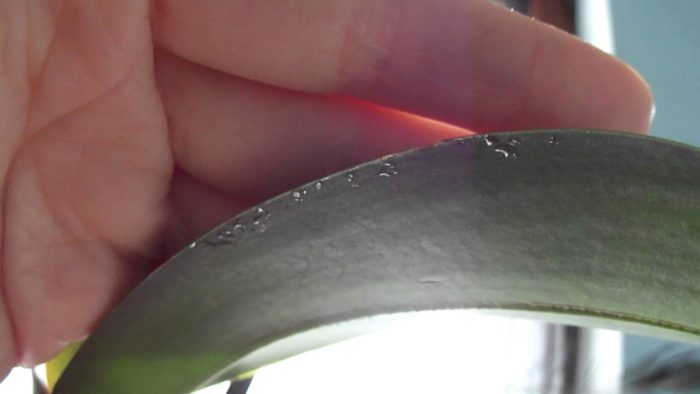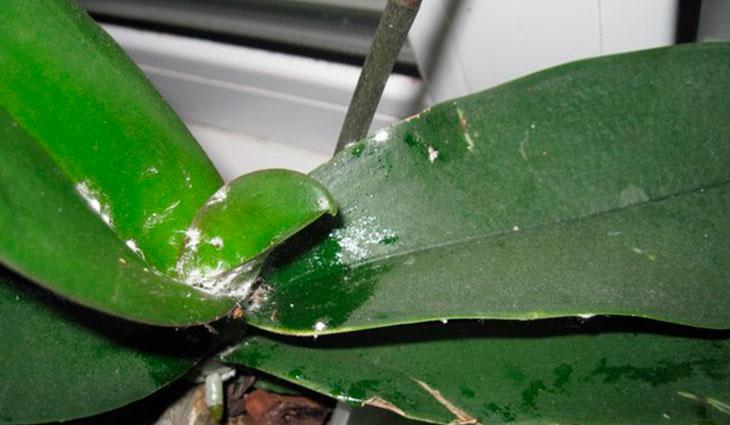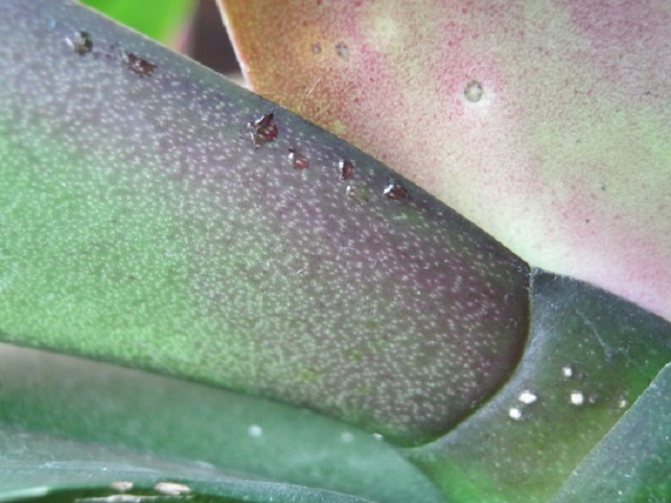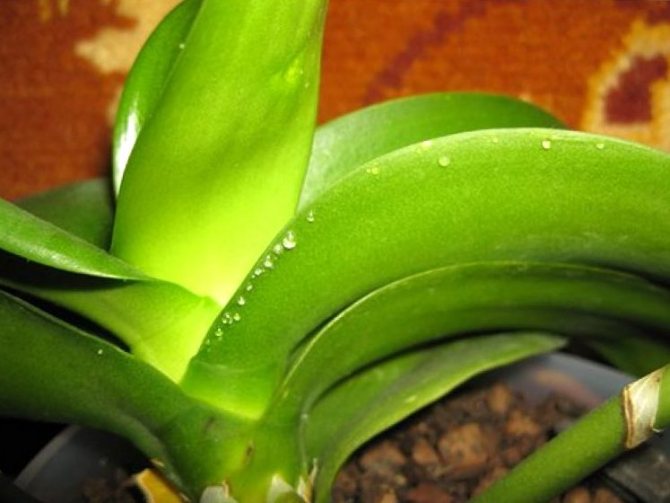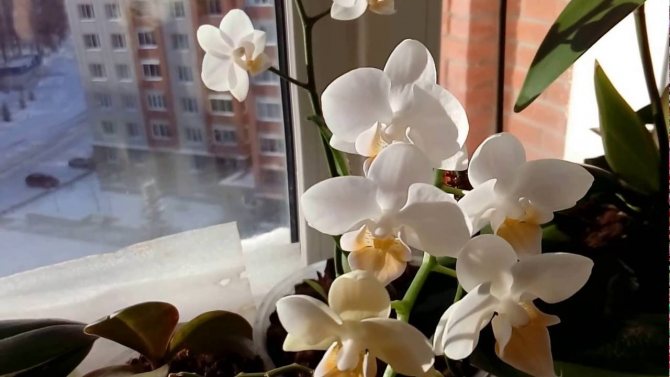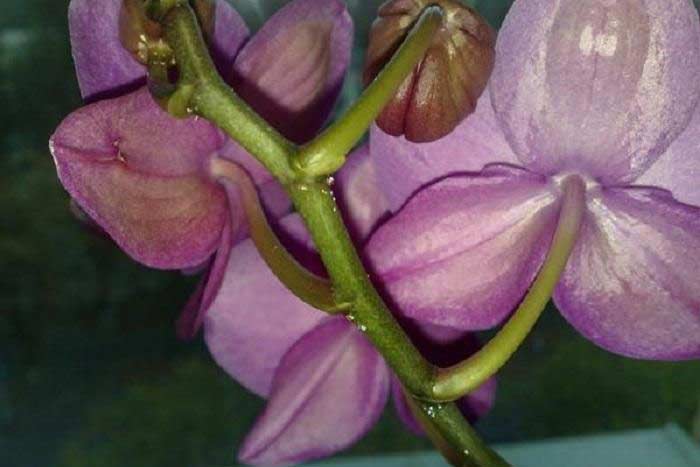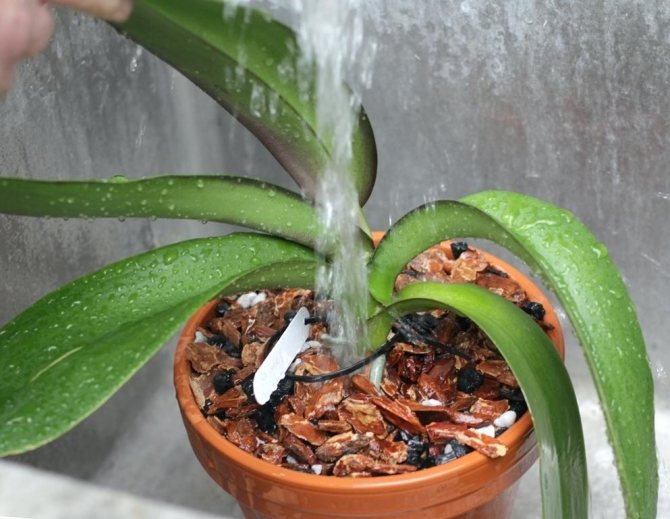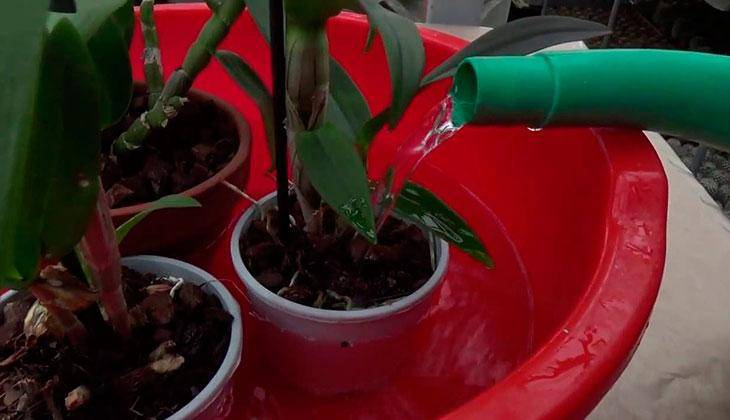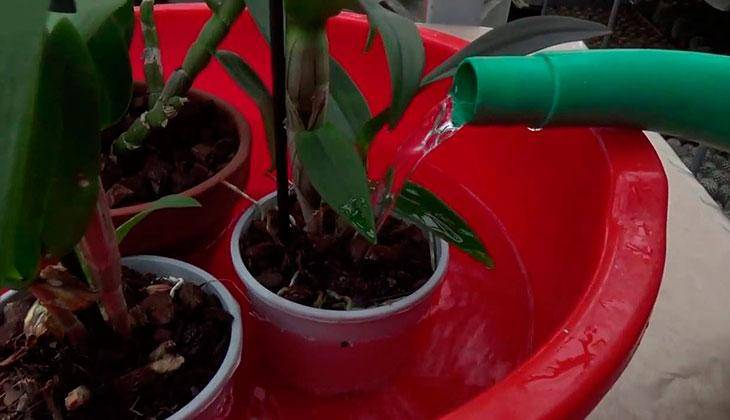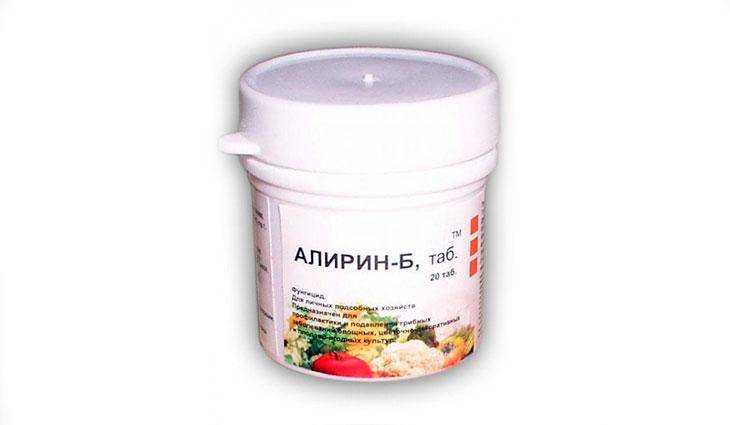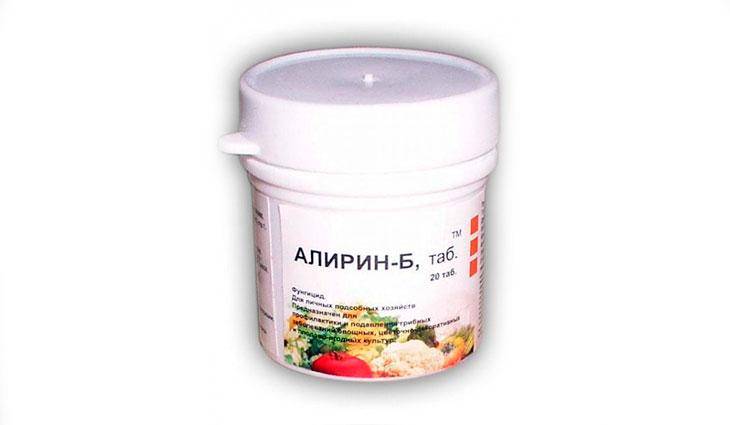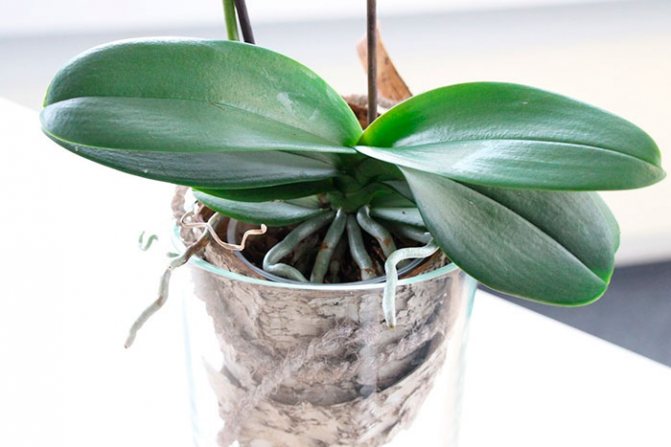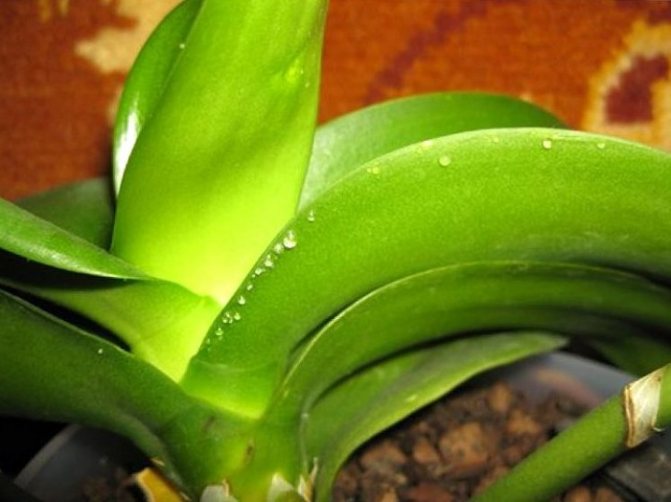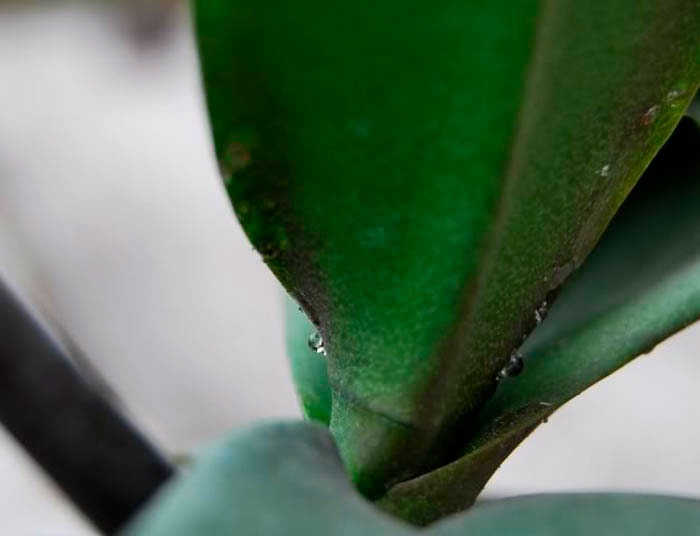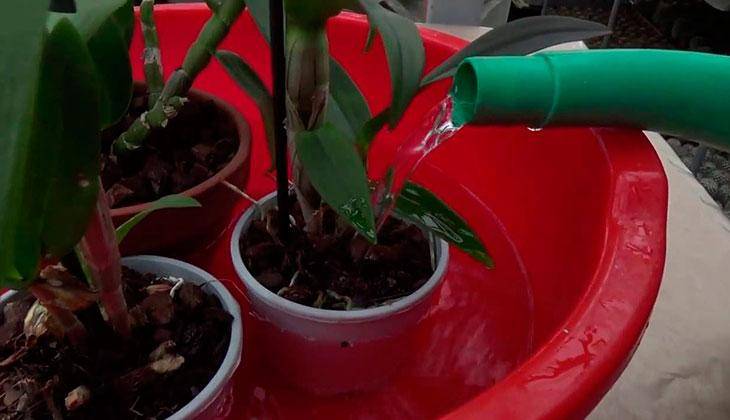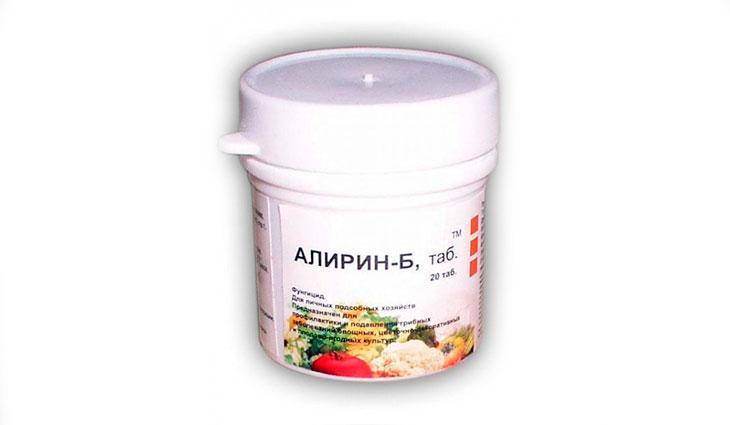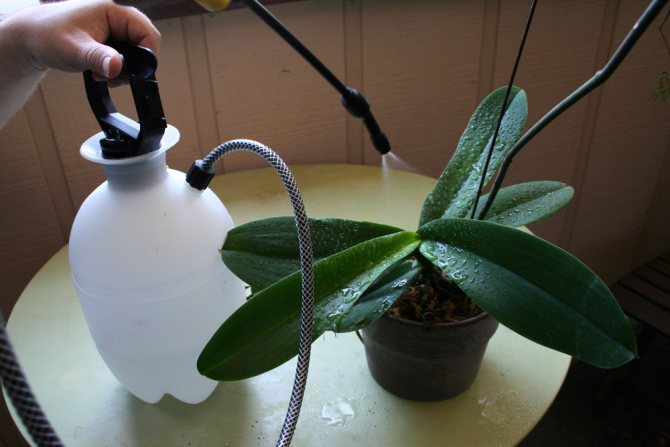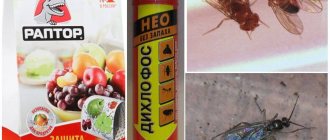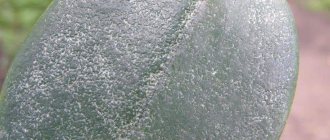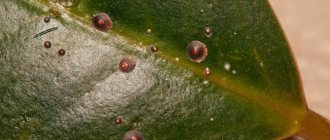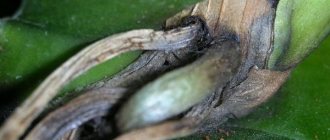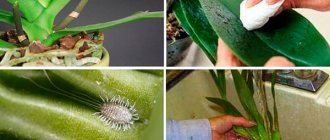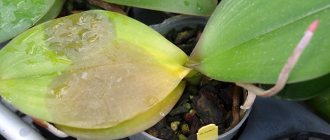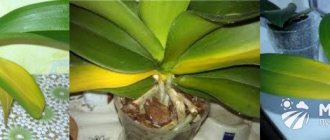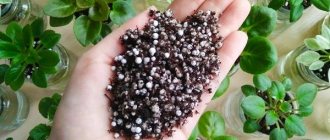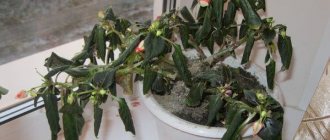The theme of the appearance of sticky drops on orchid peduncles is one of the most relevant, since it can be not only a natural manifestation of the development of a plant, but also an indicator of the development of infectious diseases or possible damage by pests.
In order to prevent the death of a flower, you must clearly follow the rules, as well as follow some simple recommendations for caring for the epiphyte.
Sticky drops on the peduncle can most often be
pathological process... They often appear on the stem or the back of an orchid leaf as a clear, sticky resin. Sometimes it can be manifestation of transpiration - a natural process by which phalaenopsis attracts beneficial insects. As a result of pollination by them, natural reproduction of exotic occurs.
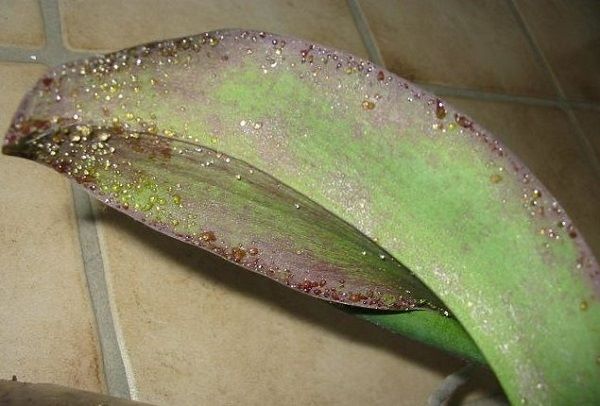
The sticky dew of orchids can attract pollinators.
In the worst case, sticky sweet pollen can be the result of pollination by harmful bugs or flaws in the care of a tropical flower.
The main causes of occurrence
The reasons for this unusual phenomenon can be varied.
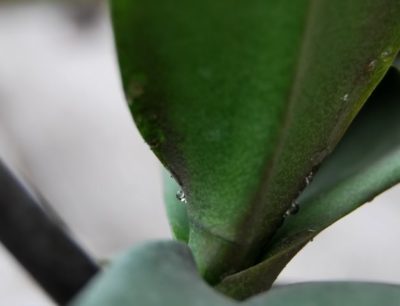

Attracting insects... Orchids in their natural habitat lure insects for pollination through sweet nectar. In this case, the formation of sticky droplets is a natural process for the processing of sugars inside the flower.- Damage by harmful insects... With poor immunity, an exotic flower is attacked by pests, in particular: aphids, scale insects, whiteflies, ticks, worms. They feed on the sap of the plant. And the sticky layer is a kind of signal for help.
- Features of the variety... Some types of orchids regularly develop a sweet layer, while others, on the contrary, never do this. And here it is not even a matter of the conditions of detention, although they may be the same.
- Disease affection... Sugar drops still indicate the defeat of an infectious disease powdery mildew. At the same time, a white bloom is noticeable on the leaves, and at later stages - fungal sporulation of black color (you can find out about diseases of the leaves of the Phalaenopsis orchid and their treatment here).
- Deteriorating conditions of detention... This item means:
- low room temperature;
- excessive watering;
- wet air;
- oversaturation with fertilizers.
We recommend watching a video about the reasons for the appearance of sticky drops on orchid leaves:
Outside flower nectar
Sometimes the cause of sticky spots is the secretion of nectar on young leaves and sprouts. This phenomenon is called "out of flower nectar" and the reasons for it are different.
In nature, such nectar is released to attract insects. They feed on sweet tasty nectar, and in return destroy or scare off possible pests of orchids. But at home, such nectar will attract aphids, even ants, which cannot be called a positive phenomenon for home growing of orchids. So, sticky drops of this origin also need to be fought.
Interesting! In nature, leaves secrete such nectar as a distraction of insects' attention from flowers. Or, conversely, it is required even more to attract insects that pollinate the flowers.
In the situation described, the plant must be placed separately and precisely determine what is causing the sticky drops. If it's just nectar, just stop feeding and watering. You may have overfed your orchid so much that it has enough strength to simply excrete sucrose droplets for no reason.
Important! But most often at home, sticky drops appear on orchid leaves due to the activity of a parasite, the development of a certain disease. So, even if it is impossible to determine the exact cause, it is better to fight the droplets. Do you know how succinic acid is useful for orchids?
What will help get rid of sticky drops (except for the methods already mentioned in the material):
- Refuse excessive watering. The roots should dry out completely, only then water the plant again.
- Strongly high humidity. With such drops, the orchid is simply freed from excess moisture. Of course, this plant loves moisture, but everything requires observance of the measure.
- If the drops are associated with pests, the orchid should be treated. If they are of a natural, natural character, then you should not touch them: the plant is so good and satisfying that it can not only absorb nutrients, but also release them.
- Staying plants in bright sun is eliminated. In such growth conditions, powdery mildew often appears on orchids, which can manifest itself in sticky droplets too. With an excessive amount of sun, the leaves of the orchid will have a purple tint, if the leaves are green, then the sun has nothing to do with the appearance of spots.
- The plant may have been struck by a scabbard. She sucks the juices out of the plant. In such a situation, move the orchid to a separate place, inspect, treat it with soapy water or special chemical compounds to prevent the spread of the scabbard.
Now it is clear what to do and whether to panic if sticky droplets appear on the orchid. Disease and parasite development can be the cause, but not always. Sometimes this phenomenon speaks of overly gentle care. A separate article contains the main reasons why the home orchid does not bloom and how to eliminate them.
podokonnik.
Why did sticky drops appear on orchid leaves?
- Any negative manifestations on the leaves, this is a signal that your plant is sick. Your plant either lacks vitamins, nutrition and moisture, or it has begun to be devoured by aphids that should be visible or clichés.
Buy fertilizers and feed the flower, if it doesn't help, then take it and disinfect it from parasites.
- Sticky droplets appear when the temperature background is not observed, when, after heat, it is suddenly sharply cold. Orchids begin to cry in sticky droplets. In addition, pests such as aphids or scale insects cause sticky droplets. Because of them, the orchid can get sick.
- Usually the cause of the sticky droplets is a disease in your orchid. In fact, it does not matter who infected the fungus or the parasite, the main thing is to take the right measures, since such a plaque is not natural for an orchid.
You can do the following to combat this phenomenon:
1) Soak the orchid in a basin in water, lowering it to half the trunk, we do this procedure for fifteen minutes. Two tablets against fungal infections, for example, Alirin-B, must be added to the water.
2) In winter, it is advisable to water the orchid less often, as excessive humidity creates an environment for such infections.
3) In summer, on the contrary, the problem is that there may not be enough moisture. Use a hot shower to water the orchid, it is also advisable to spray the air around the flower once a day.
4) For two or three weeks, spray the orchid with a drop of Zircon.
- if sticky drops appear on orchid leaves, then many are mistaken, saying that this is a sure sign of rain.the fact is that the air in the apartment is very dry and the plant does not have enough moisture, so you need to water the orchid more often if such drops appear.
- Sticky drops are a kind of protection for the orchid from drying out. With a sticky compound, it clogs its pores to prevent moisture from evaporating from the plant. By this, the orchid indicates that the air in the apartment is dry and lacks moisture, and possibly heat.
- The reason that the leaves of an adult orchid plant are covered with sticky drops is that there is not enough moisture in the air in the room where the flower stands, that is, the air is too dry.
In order to save the plant and prevent its death, it should be under running warm water rinse the leaves from sticky plaque (it is washed off extremely easily), then put in its original place, but henceforth spray it and the air around to increase the humidity. Plus timely watering.
info-
What to do if my orchid has sticky spots?
Before proceeding to active steps to treat the plant, a visual inspection is required. First of all, we pay attention to the state of the foliage.
- If, in addition to sugar drops, black spots are visible, this is a sign of powdery mildew. These dark spots can also be covered with a white bloom, and every day the places of deployment only increase (we talked about the reasons for the appearance of spots on the leaves of phalaenopsis here).
- Yellow areas on the leaves may indicate an overabundance of mineral fertilizers.
- There may be harmful insects on the back of the leaf. If they are there, they can be seen with the naked eye. It happens that insects stick to extra-flowering nectar, usually aphids.
The appearance of drops of any nature on the leaves of orchids is an unnatural phenomenon.... And if you delay the process of diagnosis and treatment, you can soon lose phalaenopsis.
Possible diseases and pests
Phalaenopsis, with improper care or a wrong place, often undergo various diseases:
- anthracnose;
- viral spotting;
- mosaic spotting;
- gray rot;
- fusarium:
- shield;
- mealybug.
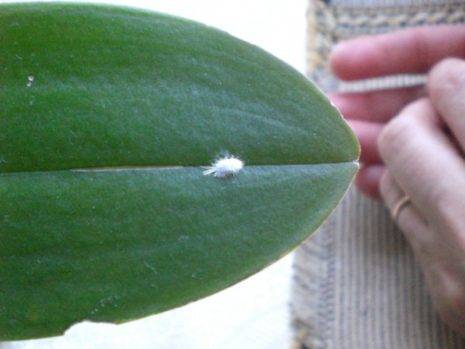

All these diseases and pests disappear only after treatment with specialized chemicals.
Anthracnose
You can often see depressed round spots on the leaf plates, which turn black and spread over the entire leaf. The reason is waterlogging. Moreover, getting rid of high humidity and reducing watering will not get rid of black spots.
Prevention. Ventilation and proper watering.
Treatment... Get rid of the affected leaf plates, and treat the cuts with brilliant green. When neglected, instead of brilliant green, they are treated with Mikosan or Skor.
Powdery mildew
Fungal disease that occurs with high humidity and high ambient temperatures. The disease is easy to identify, since the sinuses of the leaf plates are sprinkled with flour.
Treatment. Spray with Skor and adjust the conditions for keeping the flower.
Viral and mosaic spotting
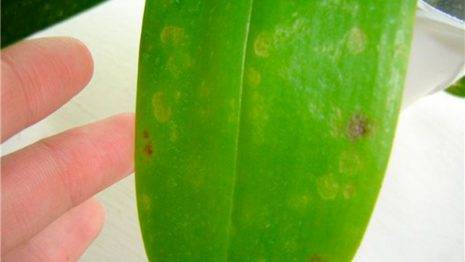

The disease cannot be treated, the plant must be destroyed.
When is it worth worrying?
- Of course, there is no reason to panic if the process of the appearance of sugar drops is physiological. It happens that domestic plants, like wild relatives, try to attract insects to themselves for pollination. In this case, sweet nectar serves as a kind of bait. At the same time, the orchid grows well, develops fruitfully, and there are no other reasons for worry. Sweet baits, into which insects fall, can further negatively affect the health of the exotic. The risk of contracting infectious diseases is possible.
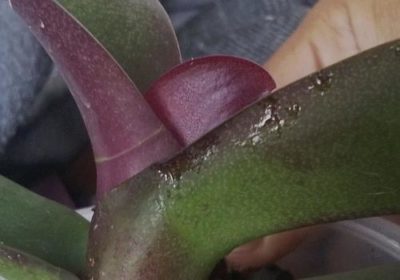

If the reason lies in the excess of nutrients - this is already serious. Through sweet drops, phalaenopsis brings out the surplus of nutrients.What is dangerous, because an oversupply of fertilizing entails the formation of rot, the death of the peduncle and the socket.- In the presence of harmful insects and powdery mildew, it is worth worrying. Immediately after confirming the likely assumptions, take action. The more neglected the state of the orchid, the more difficult it will be to cure it.
Preventive actions
Even knowing why sticky drops appear on the leaves of an orchid, and making sure of their relative safety, it is necessary to try to protect the plant as much as possible from the development of more serious diseases. Of course, the first and most important preventive measure will be compliance with the requirements for agricultural technology for growing orchids. This concept includes the regularity and dosage of watering, dressing, compliance with the requirements for illumination, temperature and humidity in the room with the orchid.
It is also useful to regularly inspect the plant and if the first sticky drops are found on the orchid, you should immediately take appropriate measures, because now you know for sure that this is not always a harmless phenomenon. As soon as such signs were found on one plant, in order to avoid contamination of other flowers, it is better to isolate it immediately and start looking for the causes and subsequent treatment.
In addition, for prophylactic purposes, drugs such as "Actellic" and "Aktara" can be used, which in the appropriate dosage will help to strengthen the immunity of the orchid.
Take care of PORN video for free - 2019 video online https://enn.imadeself.com/. Watch porn online in good quality HD for free and without registration. With the development of the Internet and high technologies, the porn industry began its active development. For the second time, about tens of years ago, men and young people had to masturbate to shabby magazines so that adults, pre-holes, re-watch erotic films with black and white quality. Shy in front of sellers in stores when buying adult films. To pry from more experienced friends: how to properly fuck a girl so that she likes it and she can finish. This has been a thing of the past since ancient times, because nowadays you can look like porn online on specific sites on the Internet. Now, in order to distort a private participant and jerk off to porn, you do not need to run to the store and generous money. Today you just need to go to the Internet and type in a search engine "watch porn". Having executed https://enn.imadeself.com/tags/%D0%92+%D0%BE%D1%87%D0%BA%D0%B0%D1%85/ a suitable request, you will see a huge number of links to resources with films for adults. From only this variety, you just need to choose an extraordinary site and video that you want to watch. Unfortunately, the overwhelming majority of such sites require payment from the user and provide this video of lousy quality, or simply "throw" their visitors for money. Don't be in a hurry to get upset. You won't have all these problems when you are born, unless you contemplate porn for free on our website. The court is that our administrators and moderators have done everything possible so that you feel as comfortable as possible and can watch and masturbate a lot of hot chicks for free. Of the other advantages of our resource, you should be pleased with the fact that our database of pornography online is updated daily with the freshest and hottest videos for 2019. Non-stop video recordings are available for you 24 hours a day and 7 days a week. Moreover, we do not require boring registration from you. You can come to our income from absolutely anywhere in the world and be in the right category only in a few clicks. In addition, all the same, video clips from the genre of Russian porn online are available for free to view from any smartphone based on Android, a tablet, that is, an iPhone, as long as the viewing of pornography overall makes unlimited.Our only goal in the creation of the site was to view the material as convenient as possible for any of our users, and for no reason to provide them with the most extensive database with materials for the sake of adults. Only the hottest girls and mature milfs from all over the world. The only sex maniac in all variations and forms. Exceptionally the most beautiful female pussies and elastic dicks of men. An unlimited number of storylines and vulgar "dirty" fantasies. That's how much you get when you land on our site. Having visited the above project at least once in your life, you will never be able to forget about it and will return to the site again and again to experience the very thrills that make our food brighter and more interesting. At any time of the day or night you have to push https://enn.imadeself.com/tags/%D0%91%D0%BE%D0%BB%D1%8C%D1%88%D0%B8%D0%B5+% D1% 81% D0% B8% D1% 81% D1% 8C% D0% BA% D0% B8 / to be able to masturbate to the most vulgar women in the world, to experience new ways of fucking, to make all the lure of dirty fantasies come true and it's completely free of charge!
Step-by-step instructions for treating the disease
So, when the cause of the sticky drops is established, you need to move on to decisive action.
Due to a sudden change in care
Plants don't like being stressed... Thus, it tries to draw attention.
Optimal indoor conditions play an important role, therefore:
- set comfortable temperature and humidity parameters in the room;
- reduce the amount of consumed mineral fertilizers;
- minimize watering in winter;
- avoid sudden changes in temperature and drafts;
- move the flower pot to the sunny side, keeping out of direct rays.
If the plaque is due to pests
The orchid produces sweet nectar to protect itself... And insects stick to it and die. Or another example of self-defense in the form of a food chain: sticky drops attract aphids, and that, in turn, ants, which can easily cope with leaf cutters.
The reasons for the formation of droplets on the leaves, trunk and peduncle
Why do sticky drops appear? There are several factors that provoke their appearance - from completely harmless to extremely dangerous:
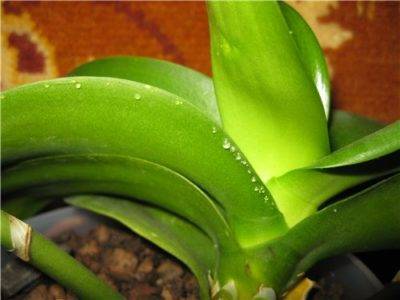

Mealybug infestation... Viscous droplets over the entire surface of the leaf and at its tips may be the first symptom of this parasite. Following the appearance of drops, the plant is covered with a white or grayish bloom from colonies of harmful insects. They multiply rapidly and poison the flower with the products of their vital activity, leading to the death of the orchid.- Other diseases: The release of a sticky substance may also indicate that the flower is suffering from attacks by ticks, worms or scale insects.
- Attracting insects for pollination: in this case, the drops are just sweet nectar that attracts creatures that can pollinate the flower in nature, such as moths, wasps, bees and even spiders.
At home, this harmless process can be dangerous, since the sweet liquid will attract not natural pollinators, but harmful ants and aphids. - Self-defense method: the plant needs nectar to divert the attention of some pests from flowers and buds - they die in viscous droplets on orchid leaves, before reaching the inflorescence.
- Abundant plant nutrition: Orchid oversaturated with artificial nutrients gets rid of excess sucrose, actively producing sweet dew on the surface.
- Irregular watering: sharp changes in the volume of moisture received by the plant, the accumulation of liquid in the pan or substrate, improperly formed drainage also provoke the appearance of sticky droplets.
We suggest watching a video about why drops appear on an orchid:
Prophylaxis
After making sure that the sticky layer is relatively safe for your pet, it is important to create optimal conditions to protect the orchid from serious diseases:
- Maintaining the temperature in summer: + 22-25 ° C, in winter + 16-18 ° C.
- Humidity 50-60%.
- Use only a disinfected, tested substrate for planting and transplanting.
- Lighting is required diffused, in the summer it is better to shade bright rays.
- Be sure to regularly ventilate the room.
- Moisten the orchid once a week. The soil should dry out completely between waterings.
- Use high quality water, free of impurities and salts.
- You need to fertilize orchids 2 times a month, especially during the flowering period. Top dressing should be used with a predominant content of potassium and iron.
- Spray with water daily.
How to fix the problem
It is necessary to choose a method of dealing with sticky drops only after determining the cause of their appearance. If the reason is waterlogging, then you need to stabilize the regime. After watering, you need to give the flower a few days of rest from the liquid. On average, in winter, an orchid needs watering only once a week. In summer, it should be watered every 3-4 days. Moss in a pot can help rid the flower of waterlogging. You need to collect or purchase dried sphagnum moss from the store and use it as mulch. It absorbs excess moisture, and then gives it away when the phalaenopsis dries up.
If the orchid began to secrete liquid due to an excess of fertilizer, then the danger does not threaten it in the near future. But the amount of dressing needs to be reduced. An overdose of certain nutrients can be harmful. After making adjustments to the care of the flower, the leaves are gently wiped with a cotton swab with warm water to remove the drops. After that, they will not appear.
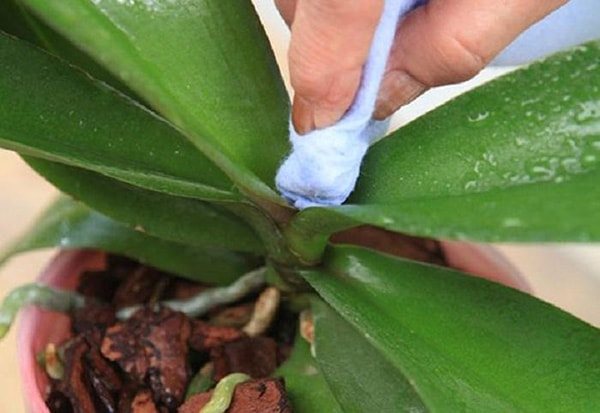

Sticky liquid must be wiped off with a cotton pad
If the cause of the drops is the appearance of parasites, then the fight must begin immediately. If the liquid plaque is caused by a worm, then the white shaggy plaque must be removed with a cotton pad, the flower should be washed with soapy water and the leaves should be treated with antibacterial agents. To prevent the parasites from returning, you need to provide suitable temperature conditions.
When a tick appears, flowers should be treated with a hot shower and disinfection. An effective way is to temporarily create conditions of high humidity. This also helps with the fight against the scabbard. The flower affected by it must be isolated from the rest and rinsed with warm water. You can use sticky tape to catch pests.
Powdery mildew can infect other pots. First, you need to send the affected flower to quarantine, and then treat it with a solution of colloidal sulfur. If the lesion on the leaves is small, then you need to cut off these areas and discard them.
Perhaps, after examining the plant, signs of damage by pests and diseases were not found, and the regime of watering and feeding does not harm the orchid. When she no longer needs extra-flowering nectar, it will disappear on its own.
Why did sticky drops appear on the peduncle on orchids?
Excess moisture in soil and air
Sticky pollen on the peduncle or the back of orchid leaves may result from high air humidity... Since phalaenopsis and other orchids are native to the tropics, exotic pets easily adapt to any area where the percentage of humidity ranges from 50 to 70.
Excess moisture in the soil plants due to excessive watering. To avoid the death of exotic plants from waterlogging, you need to observe the irrigation regime. Moisten the soil only if necessary.
If there is dew at the bottom of the flowerpot, and the roots have acquired a green or silvery hue, there is no cause for concern.
But if the gardener notices that with abundant watering, the root system began to dry out, and some roots have completely rotted, such a flower needs to be urgently saved. The situation with moist soil can only be saved by replanting.
The first thing to do when detecting sticky spots is normalize the humidity of the environment.
The second important manipulation that a gardener must take is examination of the state of the substrate and transplantation plants if necessary.
When transplanting, you need to carefully remove the exotic from the flower pot and clean it of adhering soil particles. After that, it will not be superfluous to inspect the root system for the presence of dry and decaying roots, as well as a possible invasion of parasites. If you find dried or damaged roots, you need to prune.
The operation should be carried out exclusively with instruments that have been subjected to preliminary disinfection. After the end of the manipulation, the places of the cuts must be sprinkled with charcoal or cinnamon powder.
Suitable for orchids only transparent pots and containers, since the rhizome of the flower must be saturated with light. In addition, in the bottom of the pot there must be holes - this is necessary for water access to the root system.
Extra-flower nectar
If transparent sticky drops suddenly appear on a completely healthy orchid, do not worry. This means that the plant has begun a period of transpiration. What many gardeners may mistake for a disease is actually a natural process.
How to eliminate the consequences of improper care?
In this case, it is necessary to carry out a set of remedial measures:
- washed leaves and pot;
- reduce the number of irrigations in winterso that excess moisture does not provoke the appearance of pests. Spraying is carried out with warm water with the addition of a few drops of fungicide;
- sticky discharge in summer can mean low humidity environment. Such a plant is regularly treated with hot water from the shower, during the procedure, sticky discharge is removed;
- do not allow moisture stagnation in the axils of the leaves.
Regular implementation of these rules will allow you to grow a healthy flower.
Sticky drops appeared on orchids
If sticky transparent drops are found on the leaves, you need to make sure that Does the florist take care of his orchid correctly?since they can be:
- natural manifestations - the secretion of nectar;
- be dew with excessive moisture in the substrate and air;
- it is necessary to carefully examine the plant for the presence of pests, since drops can be a product of their vital activity;
- examine for fungal diseases.
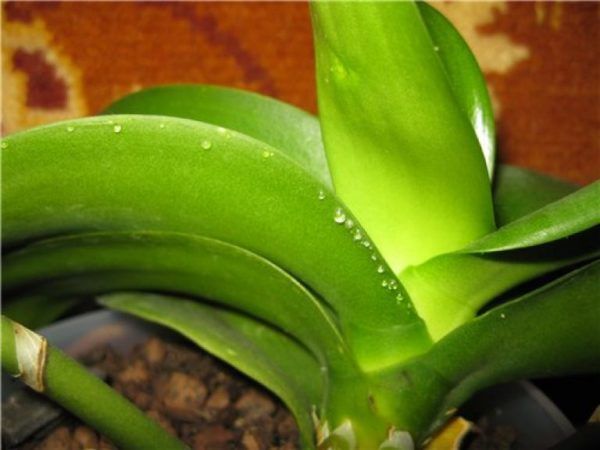

Photo of sticky drops on orchid leaves.
Natural process of life
If the grower, examining the flower and observing it for 2 weeks, does not detect pests or powdery mildew, then the appearance of sticky drops should not worry him - this is nectar, which in the natural conditions of her homeland attracts insects for pollination of flowers.
Plant uses pollination for reproduction and therefore he needs to attract various insects to this process, and the orchid does this with the help of an excellent imitation with the help of:
- nectar;
- varied and sometimes bizarre form of flowers;
- the pattern on the petals resembles flowers with nectar;
- the shape and color resembles female insects that are waiting for males;
- the aroma of some species completely intoxicates insects, luring them to itself for reproduction.
Extra-flower nectar appears on the stems of orchid plants and serves to attract insects. But it is good when the flower is in its native habitat.
If nectar appears at home, then besides the local aphid, scale insects and worms, the flower will not receive anything. therefore in a closed room when it appears, you need to get rid of it... The flower is set aside in the quarantine zone and the drops begin to get rid of the manifestation.
How to protect a plant from such problems?
To avoid the appearance of sticky drops, and various plant diseases that can be fatal, it is necessary to constantly inspect all indoor plants. If the first signs of the disease are found, the plant is separated from the others, that is, it is isolated to avoid contamination of the remaining flowers, and then treatment is started. Effective drugs for treatment are Aktara and Actellik, but other good formulations can be found.
It is necessary to pay due attention to the microclimate in the room where the orchids are located. With a sharp change in temperature at night and during the day, the plant is stressed, and sticky drops may appear on the surface of the leaves. To remove such formations, a cotton swab is dipped in warm water, and the plaque or drops are gently wiped off. It is also necessary to observe correct watering in summer and winter to prevent the development of pathogens. Air humidity plays an important role in the care of an orchid. If the correct conditions for caring for the plant are observed, the appearance of various pests can be avoided. It is necessary to regularly inspect the plant, if such a problem arises, then you need to immediately start pest control in order to save the flower from possible death.
What to do?
If a grower finds sticky dew-like secretions on his flower, the first thing he should do before treating it with chemicals is put the plant in a quarantine zone... This will help avoid contamination of the entire collection if parasites are subsequently found on the flower.
Diagnosing the problem
It is necessary to diagnose the plant. For this turn on enough light to detect parasites... To this we can add that if the grower does not have 100% vision, then you should make sure that he has a magnifying glass at hand that magnifies insects.
Because most of them are small in size and it is necessary to carefully examine the leaves, sinuses of leaf plates and roots, so as not to miss the pest.
If no harmful insects are found and there are no fungal infections, then this is nectar... You must also get rid of it at home so that it does not attract pests.
Treatment methods
It is quite easy to get rid of nectar, washing leaves and stems with warm water.
If pests were noticed, they get rid of them. chemicals, having previously removed the insects themselves mechanically and removing the sticky plaque. Then the drug is diluted according to the instructions and the plant is treated.
If there is a fungal disease on the flower, then it is treated with the appropriate fungicides until the plant is completely cured.
Pest control methods
Flower treatment is as effective as possible if it carried out immediately after identifying the problem... So, in case of detection of insect pests:
- infested orchid isolate;
- insects are removed soft tissue or cotton swab;
- cut off severely affected parts of the leaves;
- leaves washed warm soapy water;
- in case of severe damage, an orchid treated with an insecticide solution.
Prophylaxis
To prevent dew from appearing on the plant, it is necessary to organize proper care for it:
- Watering it should be done when the plant needs it, which will be signaled by the root system, changing its color to a light gray shade. In this case, the substrate will dry out and the container with the plant will be very light;
- Humidity should be at the level of 65-75%, because increasing it, you will need to have a constant flow of fresh air, and it must be warm. Therefore, it is not recommended to greatly increase the humidity;
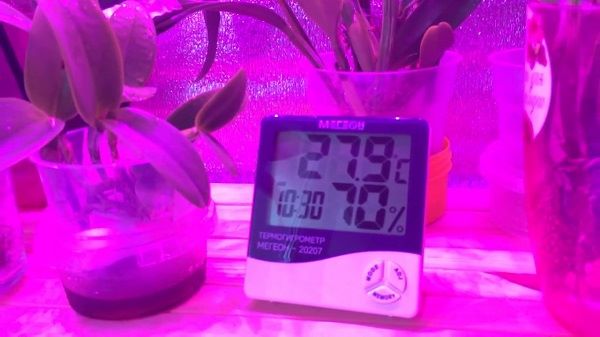

Be sure to monitor the humidity in the room.
It must be remembered that all purchased plants must be quarantined to make sure they are healthy.
Why does the plant give off liquid?
If a liquid protruding on the surface of the plant is found, the following actions should be taken to determine what caused it:
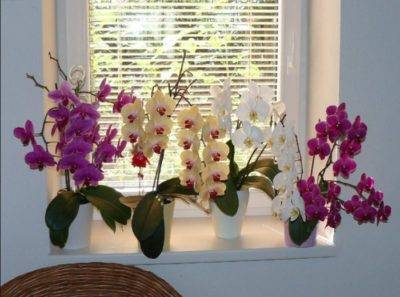

measure the temperature and humidity of the air;- the level of its aspiration;
- it is also necessary to exclude the factor of the harmful effects of direct sunlight and excessive watering;
- isolate the orchid from other flowers and conduct a thorough examination of each leaf, peduncle, rosette and substrate.
Usually, parasites can be seen with the naked eye or with a magnifying glass - directly inside the viscous droplets, on the back of the sheets, as well as in the tubercles covered with cobwebs. If no traces of damage have been identified, and the conditions for keeping the orchid are close to optimal, then, most likely, there is no reason for panic.
The release of nectar in this case is a natural process of transpiration. Otherwise, it is necessary to take measures to improve flower care and pest control.
Content errors causing the problem
When over-watered, the flower becomes covered with sticky dew-like droplets. In this way the flower is trying to remove excess moisturethat entered his cells. If incorrect watering is systematic, the flower will not cope with the removal of excess liquid and simply will start to rot.
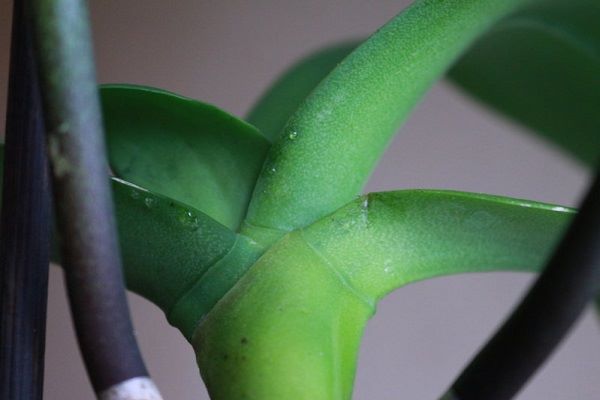

Often the orchid "cries" due to excessive watering.
So that the flower does not die it is necessary to organize the correct irrigation regime, so that the root system can breathe oxygen between them. She needs it for the process of photosynthesis.
What is dangerous
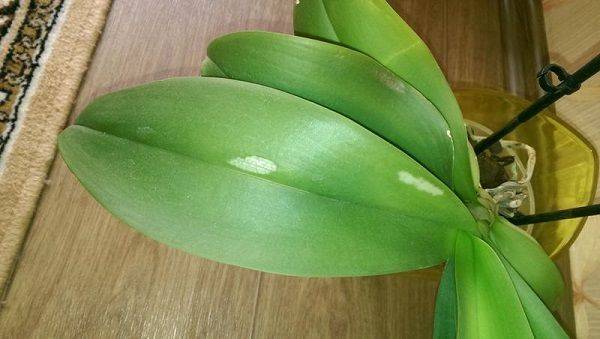

The appearance of white bloom can be caused by two reasons, each of which poses a mortal danger to the plant:
- The plant can become infected with powdery mildew. In this case, a coating, similar to a thin layer of flour, initially appears on the underside of the leaves. As the mycelium ages, the plaque takes on a dirty gray color and the stain becomes damp. If you do not take action, gradually the fungus also spreads to the upper part of the leaves, buds, inflorescences and roots. The affected areas are deformed and after a while begin to rot. Plants may die without treatment.
- The mealybug can attack the orchid. This insect is covered with protective white hairs, and the plaque on the affected leaves looks like tiny cotton wool flakes. The pest drinks the juice of the orchid, injecting poisonous substances back, which makes the plant weaker, slows down development and becomes more vulnerable to infections. In addition, a sooty fungus, which is also dangerous, likes to settle on the sticky secretions of the worm. If you do not take action, the leaves are deformed, marbled red and yellow streaks appear on them. Photosynthesis is disrupted, the plant weakens more and more and eventually dies.
Features of caring for the affected plant
- he is put in quarantine zone;
- spend processing appropriate drugs;
- create optimal living conditions for a plant;
- after removing all parasites, another 2 weeks should pass to make sure that the flower is healthy.
At the time of the restoration of the flower after processing, it can be feed with Zircon or Epin.
The reasons for the appearance of the pest
The time of activity of pests falls on the winter period. For natural reasons, the plant receives less light. This leads to metabolic disorders. A healthy, well-groomed flower is rarely the target of parasites. There are several reasons for the appearance of the worm:
- non-compliance with the temperature regime;
- low air humidity;
- abuse of nitrogen fertilizers;
- high soil moisture;
- untimely removal of dead leaves and flowers.
All of these problems lead to a change in the concentration of plant juices. Such changes contribute to a sharp increase in the parasite population.
Larvae and adults prefer to suck on areas of lush greenery - young shoots, leaves, buds. The white cotton bloom on the surface of the plant, which is created by parasites, is visible to the naked eye. In addition, a characteristic sign of the appearance of a worm is sugary discharge. If a citrus bug has settled on a plant, then the root system is also affected.
The composition of the sticky drops
If the condition is caused by over-watering, the liquid will concentrate in the soil as well as in various parts of the plant. There is so much of it that it cannot be kept inside. As a result, excess moisture is released through the leaves. A large amount of dew is formed, which a person can take for education from pests. The stickiness from the liquid is minimal as the sugar-to-water ratio is lower.
Orchid peduncle: causes of diseases and methods of dealing with them
The plant can secrete liquid on its own. It is necessary to attract insects for pollination or to kill parasites. Then the drops contain sugar particles that attract insects.
Fluid can also form due to the spread of parasites. They attach themselves to the leaves of the orchid, starting to suck the juice out of it. Then they fly over to another part of the plant. In the place where the puncture was made, the juice residue is released. It also contains a lot of sugar, making it sticky to the touch.
For your information! If the plant is exposed to bright sunlight, it begins to secrete liquid in order to protect itself. There is a deficiency inside the leaves, stems and trunk. Therefore, the plant dries up, but excessively sticky drops, like resin, form on top. This is due to the fact that there is little water in them, and a lot of sugar.
What is the danger of sticky plaque?
Regardless of what caused the infection of the orchid, the lack of proper treatment can lead to its death. Fungal infection will cause rotting of the root system and the death of the flower.
When a mealybug is affected, females of an insect pose a particular danger, since it is they who, with the help of their oral apparatus, gnaw holes in the orchid, stick to it and suck life-giving sap. In the depressions of the leaves, these parasites prefer to arrange their clutches, which outwardly look like small lumps of cotton wool.
From a flower, pests quite calmly move to pots, window sills and windows. There they hang everything with their spider web. It closes the stomata of plants, preventing them from breathing, and outwardly it looks, to put it mildly, unaesthetic.
The female scale insects are overly fertile. They are capable of laying eggs four times a year. The larvae hatch from the clutch after 10 days. Young animals are very nimble: individuals quickly orient themselves on the terrain, find a place for feeding and begin to develop. From feeding, they grow rapidly, filling more and more territories with their colonies. If untreated, such rapid reproduction will destroy the plant.
The appearance of worms can be associated with the following reasons:
- the plant was weakened earlier by the attacks of other parasites;
- the orchid received the wrong care;
- the soil was initially infected or has not changed for a long time and therefore depleted.
Ways to combat fungal disease
To eliminate powdery mildew, it is recommended to use fungicides "Topaz", "Fitosporin", "Skor". The treatment should be carried out by spraying the plants from a distance of 20-30 cm. After 1 hour after the procedure, it is necessary to wipe the leaf sinuses with a cotton swab if moisture stagnates in them.
Treatment must be carried out 2-3 times at intervals of 5-7 days, depending on the drug, until the signs of the fungus disappear completely.
For flower growers who do not accept chemicals, it is recommended to use folk remedies to eliminate the disease:
- Garlic. Grind 5 cloves of the vegetable component and pour 500 ml of warm water.Insist the mixture for 5 hours in a closed container. Subsequently clean and use for spraying.
- Field horsetail. 100 g pour 500 ml of boiling water. After 2 hours, clean and use on the affected plant.
It should be understood that folk remedies are effective only at the beginning of the development of the disease, as they have a gentle effect. When the situation is critical, it is better to use fungicides.
How to fix problems and create ideal conditions for your orchid
Once you have figured out the causes of the disease of orchids "crying" with sweet tears, start the fight:
- Pest insects multiply so rapidly that it is necessary to treat the plant immediately after they are found. You can remove parasites mechanically (bathe the orchid), folk or chemical. The choice of control method depends on the size of the insect colony. Do not forget that most drugs kill only adults, and re-treatment will be required to get rid of larvae and eggs.
- To cure an orchid from powdery mildew, purchase a drug from a flower shop. Many modern fungicides are safe for plants, pets, and people.
- If sticky spots appear as a result of improper maintenance of the flower, create a comfortable environment for it.
In order not to have to treat the orchid, choose a suitable place for it and take care of proper care:
- In natural conditions, the orchid grows under the canopy of tropical trees, it needs diffused sunlight. The midday heat can cause burns on the leaf blades.
- The temperature regime is 19-25 ° C during the day with a slight decrease at night.
- The usual water for humidification is rainwater. Use a soft, settled, slightly warmed liquid for watering. Do not flood the orchid, the substrate should dry out between waterings.
- For normal development, the orchid needs a moisture content of about 60%. Try to ensure this indicator not only in summer, but also in winter, when the heating system is on, which dries out the air.
- Buy a special fertilizer for orchids, strictly follow the instructions, do not overfeed the flower.
- Transplant the plant into fresh substrate as needed.
If you follow all the rules of care, the orchid will delight you with bright healthy foliage and abundant flowering. An attentive florist will promptly notice the appearance of a sticky mass on the leaves and help the plant.
Where can transparent droplets appear?
Viscous transparent droplets can form on different parts of the plant:
- on the leaves;
- flower shoot;
- bulbach.
On the leaves
Drops appearing on the underside of a leaf are not always a cause for concern. This can be a natural transpiration process. The occurrence of infection or parasites is indicated by the simultaneous presence of plaque or stains. There are also parasitic insects that leave a shiny, sticky trail (aphids, mealy worms, suckers). Still, it is worth making sure of the health of a tropical flower and excluding infection.
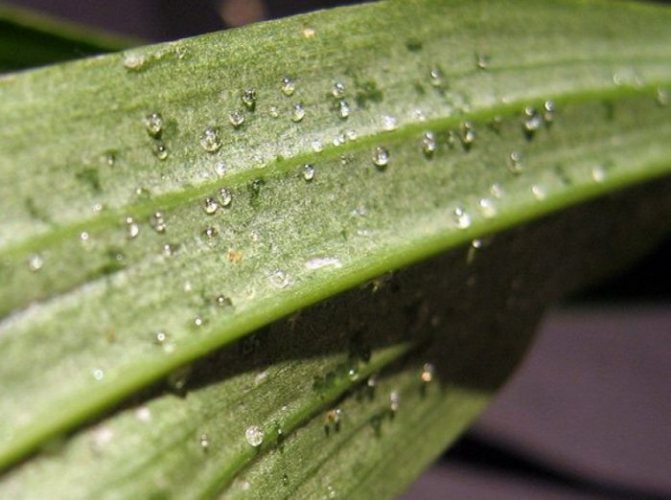

On the peduncle
Sticky moisture on a flower shoot signals improper care and an unsuitable microclimate for the plant. Here, the drops are more difficult to notice, they look like water that accidentally fell on the peduncle. However, this feature should not be overlooked. Errors in care weaken the immunity of the orchid, leading to the development of diseases. If drops are found, excessive watering and high humidity should be immediately excluded.
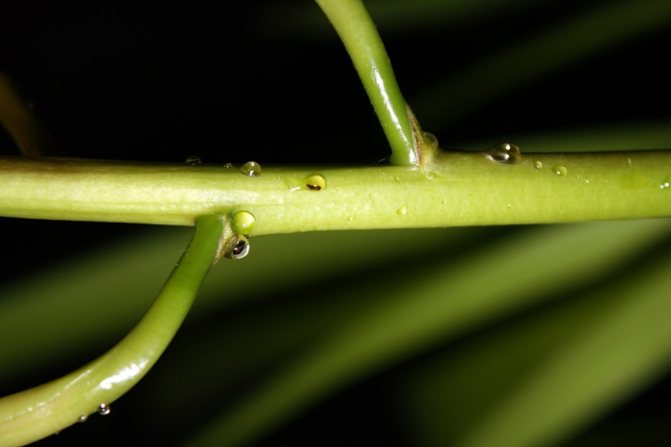

On bulbs
Bulbs are called the body of Phalaenopsis. The appearance of sweet drops on these parts of the plant may indicate an incorrect watering regime or the presence of pests. Here it is immediately clear that the orchid is in danger. The owner should immediately begin to take measures to save the flower.
Types of worm
Among the many representatives of the insect family, there are several species that cause concern to lovers of indoor flowers.
- Bristly mealybug (Pseudococcus adonidum) - damages to the plant are caused by females and insect larvae. The body of adults is orange or pink. It is covered with a mealy bloom. Females reach a length of 5 mm, males are smaller. The pest secretes a large amount of honeydew (sweet secretion), which causes the appearance of the fungus. This species is viviparous, its representatives are actively spreading over the orchid.
- Seaside mealybug (Pseudococcus affinis) - this species is the most widespread. The body of the female is elongated, pinkish-gray in color. A mealy bloom is clearly visible on its surface. Males grow up to 2 mm, they use wings to move. Females do not fly, their length is 3-4 mm. Well-developed legs allow them to look for the best places to feed and lay eggs.
- Citrus mealybug (Planococcus cirti) - the color of the pest ranges from yellow to brown. The body is covered with a waxy coating; thick bristles are visible on the sides. Females leave behind a sticky sweet honeydew.
Information. More than 2000 species of mealybugs have been found in the world. Most prefer tropical latitudes, 300 species are found in Europe.
Preventive measures so that the flower does not become covered with white fluff
In order to avoid such problems with the orchid, you should follow some preventive measures:
- Water the orchid only when the soil is completely dry.
- Periodically arrange a warm shower for flowers to remove excess moisture from the sheet plates.
- If the temperature drops, reduce the number of waterings.
- When shortening daylight hours, use phytolamps.
- Observe the temperature regime.
- Perform a preventive treatment every three months.
- Transplant orchids only into proven soil.
White bloom (mealybug) - the reasons for the appearance and possible options for getting rid
As it has been said more than once, the beauties of orchids have become the favorites of many flower growers, which is due not only to the beauty of this plant, but also to the long period of its flowering. Not many beautiful flowers can decorate our home with their flowers for more than six months, as the orchid often does.
Nevertheless, we often have to deal with various problems, diseases and ailments that affect this flower. In this article, we will tell you more about how to deal with the appearance of white bloom on an exotic beauty. By the way, you can also read our article on the signs of orchid diseases.
In the event that you notice a strange whitish bloom on the leaves of your orchid, you should not be afraid, it is worth taking action, because this means that your plant has problems that you can cope with. We'll tell you how.
The reasons for the appearance of such a plaque can most often be two:
- the presence of a parasite on orchids called mealybug. It hides on a plant in the form of motionless tubercles. It is not so difficult to find it, since it practically does not move, which also makes it easier to fight with it, but even so, it can cause significant damage to your orchid before you notice it and start fighting it;
- high air humidity, which, in the end, leads to such a disease as powdery mildew. In this case, the plaque is more reminiscent of flour or some kind of white powdery substance. If you do not act immediately in this case, you are putting your plant at risk of death.
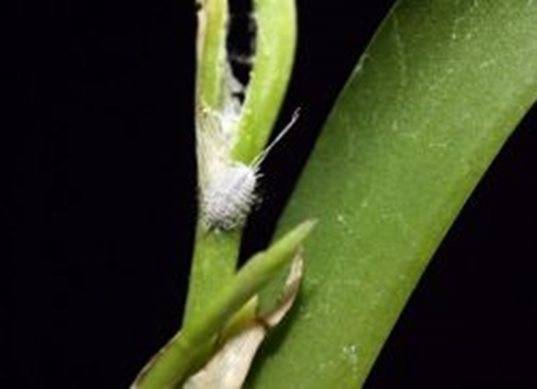

WAYS to get rid of white bloom on orchids:
In the event that your plant has suffered from the influence of a mealybug, you need to take the following measures:
- the first step you must take is isolating the diseased plant from others;
- as regrettable as it sounds, you will have to remove the buds and existing flowers;
- we clean the leaves of the plant with an ordinary cotton swab, treating all hard-to-reach places so that no harmful plaque or insects remain there and cause you new problems;
- disinfect and carefully examine the windowsill and everything around the place where your orchid was located, since these harmful insects can live both on the plant itself and on surrounding objects;
- the final stage is a thorough treatment of the orchid with insecticides, which are contained in preparations such as dimethoate pasration, malathion or diazinon. Correct processing should take place in the form of spraying 3-4 times with an interval of 10 days.
If the plaque is causing powdery mildew, you can do the following:
- spray the plant with phytosporin, for greater reliability it is proposed to do this several times;
- change the location of the orchid, eliminating the possibility of a repetition of the problem.
Avoiding orchid disease, namely mealybug
In order to avoid similar problems, we advise you to simply constantly monitor your orchid, choosing the optimal maintenance regime for it, while constantly wiping its leaves, keeping an eye on the cleanliness of the plant.
One of the most common and quite dangerous insects that can significantly damage the health of your orchid is the mealybug. In this article we will tell you how to deal with this harmful insect, how to identify and prevent its appearance, as well as how to get rid of it completely.
The mealybug is an insect of small size, oval in shape, the length of which reaches 3.5-5 mm. Its color can be quite different, but most often it is white, beige or pink, with the presence of transverse grooves on the back. On the edges of its body, bristles and a white powdery coating can be distinguished.


The insects that are directly on the flower and do the most harm are females. They practically do not move, strengthening in one place and forming a white bloom around themselves, similar to cotton wool. It is this plaque that is the most noticeable signal that a harmful insect is on your orchid. Seeing the plaque, you can also notice the insects that are located under it, which are the worms themselves, which you need to get rid of as soon as possible, since they can cause many diseases of the phalaenopsis orchid.
The action of mealybugs has a really deep detrimental effect on the plant, since they suck the juices from the orchids, at the same time, injecting poisonous substances into the flower, from which the orchids are weak, their growth slows down, the leaves fall off and turn yellow. The first symptoms you'll notice are sticky droplets all over the leaves. During the same period, a white bloom may form, which we have already mentioned, and which is even easier to notice. If the damage to the flower is prolonged and severe, then this can often cause deformation of flowers and buds, as well as a marbled color of the leaves with the appearance of yellow or red spots.
The main reason for the appearance of these insects on an orchid is suboptimal keeping conditions. This means that these pests almost never appear on healthy plants that are immune to them. In most cases, they affect plants that are already weakened, the metabolism of which has been impaired for one reason or another. Nitrogen oversaturation can often be such a reason, which is also detrimental to the health of the orchid. You need to be especially careful in the winter period, since it is the most dangerous from the point of view of complicating the creation of the necessary climate for an orchid, with the presence of the correct lighting, fertilizer, temperature, moisture, and the like.
What can you do so that you no longer know what a mealybug is?
- firstly, you need to inspect all the plants that you bring home and put along with the existing flowers, because this is one of the most common types of this insect getting into your collection of flowers. Thus, we advise you to carefully inspect all those flowers that you already have, and especially those that you have recently acquired.
- in order to protect your plants from any harmful influence, they should be subject to regular inspection, which will help you to prevent the appearance of "unexpected guests".
Rules for how to deal with mealybugs correctly:
- Isolate it from all other plants, protecting them from the possibility of infection;
- Mechanical cleaning - removing flowers, buds, cleaning infected leaves with a cotton swab, removing insects from the entire surface of the flower;
- Removal of severely affected leaves;
- Thorough cleaning of the trunk and other parts of the orchid from insects;
- Moving the plant to an environment with higher temperatures and higher humidity, since such conditions negatively affect mealybugs;
- Thorough examination and cleaning of all objects around the environment where the flower was located, as insects can also be found on external objects
- Alternatively, you can treat the plant with medicines or folk remedies that help in the fight against this type of insect.
From our own practice, we can advise the use of the following chemicals for processing plants for the final and reliable destruction of mealybugs: Dimethoat, Parathion, Malathion, Diazinon
In order to ensure the complete destruction of pests, these drugs will have to be applied 3-4 times with an interval of 10-14 days.
How to identify a pest
Mealybugs are small insects 3-6 mm in size. Their oval body is covered with a waxy coating. In the back there are plates of various lengths. The insects are white or beige. Small setae are located along the body, transverse grooves on the dorsum. Pests are mobile at any age, they move around the plant, sink into the substrate, and spread to neighboring indoor flowers. Mealybugs belong to the coccidi superfamily. They are close relatives of the scale insect, another type of insect that parasitizes orchids.
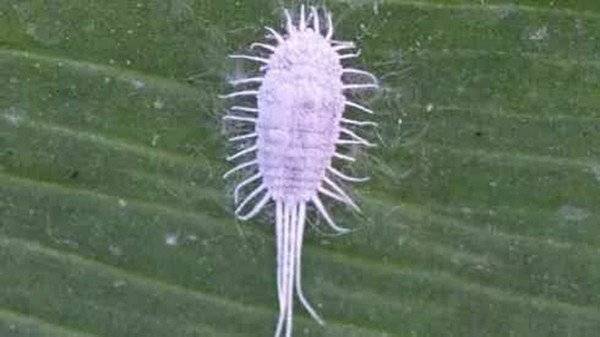

Mealybug
Information. The common name for mealybugs is hairy lice.
In worms, sex differences are pronounced. Males have wings, but they lack a mouth apparatus. Adult males do not feed. After mating, they soon die. Wingless females live in large colonies. They have a long proboscis for piercing the plant and sucking out juices. Before laying eggs, females create white, cotton-like sacs. On the leaves of plants, they look like a plaque, by which they determine the presence of a mealybug on an orchid.
Fertile females bring 3-4 generations of insects per season. The larvae, emerging from the eggs, actively move through the plant. They look like light gray fluff. After choosing a convenient place, the larvae stick to the plant and feed on the sap. Soon they molt, the older individual is looking for a new place. Females can lay eggs in a secluded place near the flower, the larvae find their way to the orchid.
The pest prefers to live and feed in the recesses of the leaf sinuses. Adult females crawl into the buds and flowers of the orchid. With severe damage, the flowers are deformed, and a marble color appears on the leaves. The mealybug weakens the plant, promoting secondary orchid diseases. In addition to sucking out nutritious juices, the pest leaves specific secretions that get inside the leaves and flowers. The digestive enzymes of the parasite slow down the metabolic processes of indoor plants.

